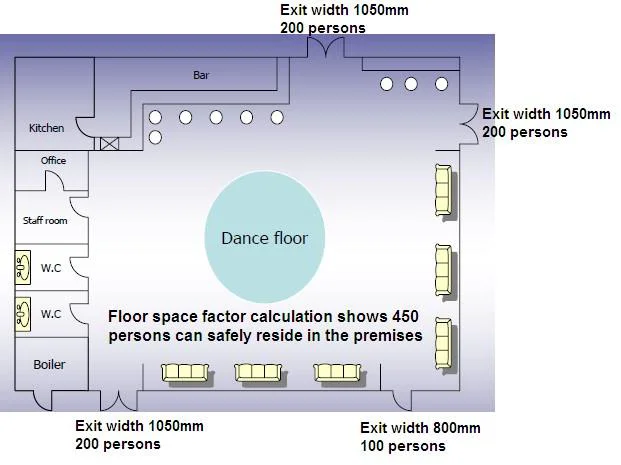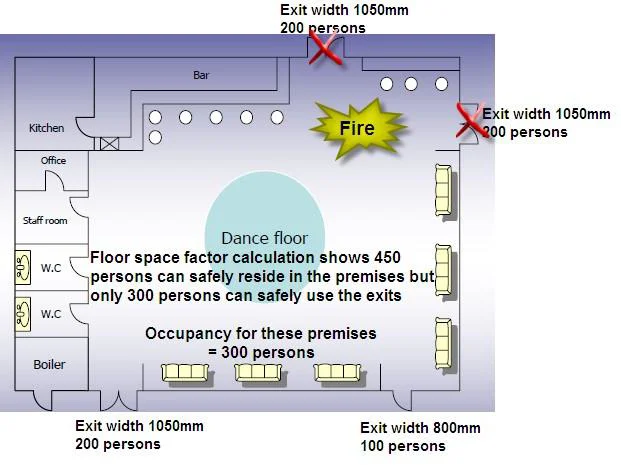Occupancy calculations
The following information has been extracted from the CLG guide for Fire Safety Risk Assessment in Small and Medium Places of Assembly under the Regulatory Reform (Fire Safety) Order 2005 and Building Regulations approved Document B (ADB).
Escape routes need to be adequate for the people likely to use them. You will need to consider how many people, including employees and the public, may be present at any one time. Where premises have been subject to building regulations approval, the number and width of escape routes and exits will normally be enough. However, in such buildings where the risk has changed or buildings were constructed before national building regulations, it will be necessary to confirm the provision.
You also need to be aware of any licensing requirements and capacity limits set by your license, although these may not be directly related to fire safety.
The occupancy figure for any building is based on the lesser of the two following calculations; the number of persons who can safely reside in the premises (using the floor space factor may assist in working this out) and the width and capacity of the exit routes to allow them to escape safely.
Floor space factors
Floor space factors may assist you in working out the maximum number of persons who may safely reside in the premises and are based on the following table taken from table D1 in Building Regulations ADB vol. 2.
Note: This is only an extract of the full table. Please see full table for details.
Note: Only calculate for the main function areas. Take care not to include stairs, exit routes (corridors), toilets, plant rooms etc.
| Type of accommodation | M2 per person |
|---|---|
| Standing spectator areas, Bar areas within 2m of serving point, or similar | 0.3 |
| Assembly Halls, Dance floors, Concert venues, Bar areas without seating, or similar | 0.5 |
| Dinning rooms, Seated Lounge/Bar, Restaurants, or similar | 1.0 |
| Art gallery, dormitory, factory production area, museum or workshop | 5.0 |
| Office | 6.0 |
| Storage and warehousing | 30.0 |
Where you have fixed seating then the maximum numbers of people in the Hall, Bar or Restaurant will be known from the number of seats provided. If you are providing temporary seating then this may be limited by the maximum numbers your escape routes can accommodate.
e.g. Bar area of 100m2 ÷ 0.5 (floor space factor)= 200 persons and 50 seats around the side of the room Total occupancy = 250 people.
Widths of escape routes and exits
Minimum width for an escape route should ideally be 1050mm but in any case not less than 750mm and where wheelchair users are likely to use it not less than 900mm. The premises fire risk level will be obtained from your fire risk assessment (use medium risk if you are not sure of your premises risk level).
The below table is taken from Part 2, Section 4 of the CLG Guide for Small and Medium Places of Assembly.
| Minimum width on escape route or exit | Premises Fire Risk level & Persons |
|---|---|
| At least 750mm |
Low risk = up to 120 persons Medium risk = up to 100 persons High risk = up to 80 persons |
| At least 1050mm |
Low risk = up to 240 persons Medium risk = up to 200 persons High risk = up to 160 persons |
| Every 75mm over 1050mm | 1.0= +15 persons regardless of risk level |
When calculating the exit capacity you must remember to discount the largest exit or exits if they are close together (see example below), as they may be unavailable due to the fire. Then add together the number of persons who can safely use the remaining available exits.
Note: An occupancy limit of 60 persons will apply where only one exit exists and 60 persons is the limit for an exit where an exit door opens inwards (unless that door is fastened open).
Other guides are available which may also assist in calculating a safe and accurate occupancy figure for fire safety in buildings e.g. Building Regulations, BS 9999.
Example calculations for occupancy figure


E.g. Exit A, B and D (all 1050mm wide) = 200 x 3 = 600 persons, Exit C (800mm wide) = 100 persons. Discount either the largest exit, or those exits which are close together (A+B), then total exit capacity is Exit C + Exit D = 300 persons.